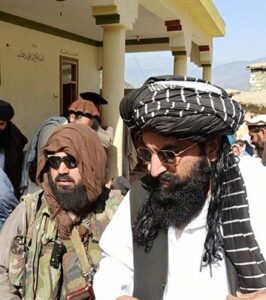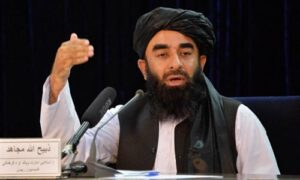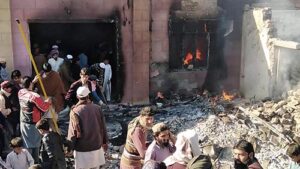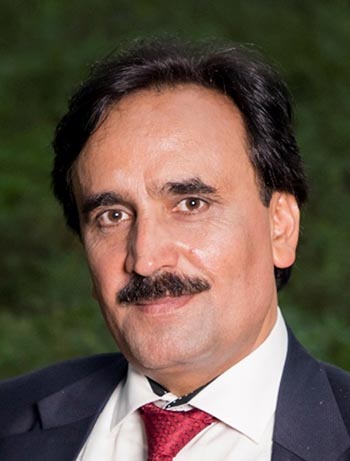The year 2021 has left some daunting challenges for the new year. The major challenge that Pakistan faces in 2022 is increasing terrorism and extremism. There had been a reduction in terrorism since June 2014, after the Zarb-e-Azb military operation was launched. The largest militant group, Tehreek-e-Taliban Pakistan (TTP), faced serious rifts in September 2014; many senior commanders left the main group and formed a new one: Jamaat-ul-Ahrar. The Khan Saeed Sajna group had also defected from the group. Some other commanders had also started operating independently, including Shehryar Mehsud. In 2017, the Hizbul Ahrar had emerged from Jaamat-ul-Ahrar, putting the TTP almost on the back foot. However, the killing of Mullah Fazlullah in a US drone strike in June 2018 proved a blessing in disguise for the TTP, as the new Emir, Mufti Noor Wali, prioritised unity among the different factions and after a two-year effort, he managed to reconcile with the Hizb-ul-Ahrar and other factions and smaller groups in August 2020. In 2019, the militant attacks in the country had gone down to the level of 2004, which was a historic improvement in the country’s security situation. However, since the reintegration of the TTP in August 2020, the group stepped up its attacks, which further intensified in 2021.
According to the Pakistan Institute for Conflict and Security Studies (PICSS)’ Annual Security Assessment Report, a substantial increase in militant attacks in Pakistan was observed in 2021 as the country witnessed more than a 57 percent increase in militant attacks, a 48 percent increase in the number of deaths and close to a six percent increase in the number of injured as 294 militant attacks were recorded in 2021 in which 395 people were killed and 629 others were injured. Balochistan witnessed 104 militant attacks in which 177 people were killed while 346 others were injured, as compared to 103 militant attacks in FATA that caused the death of 117 people besides injuring 103 others. As many as 58 militant attacks in Khyber Pakhtunkhwa (KP) during the year suggest that the province is increasingly inching back to violence. Around 62 people were killed and 58 others were injured in KP. In Sindh and Punjab, 15 and 10 militant attacks respectively, were reported, and three militant attacks in the Islamabad Capital Territory indicate that militants have made consistent efforts to make their reach felt in urban centres. Improvised Explosive Device (IED)-based attacks, targeted killings and physical assaults were the three most lethal types of attacks. They constituted 84 percent of the total militant attacks (248 out of 294) in 2021. IED-based attacks were the most common, constituting 32 percent of the total attacks, followed by 30 percent incidents of targeted killings and 22 percent physical assaults. Grenade attacks formed nine percent, while suicide attacks were around two percent.

Interestingly, when attempts were being made to reintegrate the TTP, efforts to form a united front of Baloch militant groups fighting against the Pakistani state were also in progress. The Baloch Raaji Ajoi Sangar (BRAS) was formed in November 2018, the same year that Mullah Fazlullah was killed.
In 2021, when the TTP halted its attacks for one month, from November 9 to December 9, the overall number of militant attacks still remained on the higher side because Baloch militants had stepped up their attacks. Not only did the unification of the Baloch militants and the TTP happen almost during the same period, but the intensification in the attacks also coincided. Interestingly, Baloch militants have also established contacts with the TTP and other anti-Pakistan groups. Pakistan is faced with an enemy that has many faces, but somewhere along the line their objectives are intertwined and, perhaps, also their resources. Pakistan has been blaming India for sponsoring both terror groups. However, just allegations or finger-pointing will not resolve the issue.

The year 2022 may see more attacks by all shades of militant groups. The Sindu Desh Liberation Army is a new entrant, which has reportedly joined BRAS and claimed responsibility for the attacks in interior Sindh. While the tribal districts of KP and Balochistan are already facing serious challenges, interior Sindh will also prove to be another headache for the country.
Pakistan, in particular, will face increasing pressure in erstwhile FATA (Federally Administered Tribal Areas), where the TTP will try to win back some territory to relocate its command and control structure as it faces pressure from the new Afghan government to either thrash out a deal with Pakistan or stop using Afghan territory for mounting attacks on Pakistan. The local commanders and leaders of the new Afghan government, however, have very strong and deep-rooted ties with the TTP and its leadership. The latter had provided shelter and support to Taliban leaders and fighters, when it was facing severe US military pressure in Afghanistan. Although the Afghan Taliban never expressed any desire or intent to expand their military campaign outside Afghanistan, their strong bonding with the TTP leadership and fighters was perhaps underestimated in Islamabad. The general impression was that with the Taliban ruling Afghanistan, the TTP and all anti-Pakistan elements hiding in Afghanistan would have no room to stay. This impression was further strengthened with Pakistan’s consistent diplomatic push to urge the international community to engage with the new Afghan government. The PTI government expected the new government to reciprocate Pakistan’s efforts, but it soon realised that the Taliban leadership no longer enjoyed full control over its local commanders, as it did in its previous tenure in power. Despite the amnesty announced by the Taliban’s top leadership, the local commanders indulged in revenge killings and torture of members of the former security forces. Mullah Haibatullah has set up a commission to address the issue, but the problem persists. Some TTP members were also seen with fighters of the Islamic Emirate of Afghanistan (IEA) when the fencing wire was stolen from the Pak-Afghan border and abuses were hurled at Pakistan. Interestingly, while members of the IEA were seen destroying and stealing the fencing wire and poles, in certain places, at another place a commander of the IEA was seen thanking Pakistan for its support during the war against foreign forces. The Taliban leadership is not on the same page regarding Pakistan and this is reflected in the rank and file of the new regime too.
Given the limited control of the top leadership of the Taliban, not only will Pakistan continue to face problems on the Durand Line, but the TTP and other elements will also use the situation in their favour and cross-border infiltration and attacks will continue.
Having said this, there are prospects of talks between TTP and the Pakistan government resuming soon. However, the outcome depends largely on the will and the intent of the Afghan Taliban. If the IEA puts serious and genuine pressure on the TTP, a deal is most likely. However, there is nothing Pakistan can offer to the TTP, except a general amnesty and reintegration of its fighters in society, with some safety valves in place after addressing the concerns of those who were directly affected by the TTP’s violence. The TTP, on the other hand, believes that it can also win against Pakistan just as the Afghan Taliban did against the US. The group wants to exploit the positive public opinion of the Afghan Taliban and the negative feelings against Pakistan’s security forces in the tribal belt to further its ingress in society and enhance its support base. The TTP is utilising anti-military sentiments fomented by the Pashtun Tahaffuz Movement (PTM) in the last few years in the tribal belt for new recruitments to its militant agenda. Utilising hard and soft measures, the TTP aims to win back some territory before entering into any negotiations. However, it is highly unlikely that the Pakistan army will concede any territory to them in the ongoing battle. The Pashtun belt of the country will probably witness more violence.
Although the Baloch militants residing in Afghanistan have been facing problems since the Taliban takeover of Kabul, their militant activities on the ground are increasing. But 2022 is expected to spell more troubles for the Baloch militants as Pak-Iran ties are normalising gradually and Pakistan hopes that Iran will squeeze the space for Baloch militants on its soil.
Unfortunately, intolerance and extremism continue to grow in Pakistani society; incidents of communal tension were witnessed in the country and these will continue to pose a serious challenge for the state.
A recap of the recent incidents shows that on December 30, 2020, a mob vandalised the temple of a Hindu saint and subsequently set it on fire in the Karak district of Khyber Pakhtunkhwa, as more than a thousand people, led by some local elders of the Jamiat Ulema-i-Islam-Fazl (JUI-F), held a protest, delivered speeches inciting people and then attacked the temple. Subsequently, the Karak police arrested 31 people, including the district leaders of the JUI-F, Rehmat Salam Khattak, for vandalising and demolishing the temple. The temple was subsequently reconstructed by the KP government. In May 2021, a mob attacked the Golra Police Station in Islamabad in an attempt to lynch a man who was detained on the charge of blasphemy. In August 2021, hundreds of people vandalised a temple in the Bhong area of Rahim Yar Khan after a nine-year-old Hindu boy — who allegedly urinated in a local seminary — was granted bail by a local court. In late November, a mob in Charsadda, ransacked a police station and burnt it down on similar allegations. The KP police had reportedly refused to hand over a man detained over alleged blasphemy to the mob. In another shocking incident on December 3, a Sri-Lankan national Priyantha Kumara, working in a private factory in Sialkot, was tortured to death and his body was set on fire on blasphemy allegations by an angry mob. According to initial reports, the Sri Lankan national was accused by the factory workers of “tearing down the Durood Sharif” (words in praise of the Holy Prophet Muhammad). However, some media reports claimed that he had removed a banner of the TLP from the factory walls and supporters of the TLP in the factory accused him of blasphemy. The TLP leadership subsequently denied their involvement and condemned the incident.

It seems that a consensus is developing in Pakistan’s official circles that the issue of extremism can be addressed only through revamping Pakistan’s judicial system and that a strict application of the law will avert or deter issues such as the lynching of people like the Sri Lankan national, Priyantha Kumara. The Council of Islamic Ideology (CII) on December 20, 2021 observed that a serious issue facing the country was the non-implementation of laws and that the judicial system needed improvements in order to stop a recurrence of the Sialkot-like incident. Similarly, on December 24, PTI leader Dr Babar Awan tabled a resolution in the National Assembly for holding a debate on the Sialkot tragedy. He was of the view that the penal system needed to be improved so that those guilty of violent crimes could not take advantage of loopholes or flaws in the system to escape punishment. In the Senate the same day, following Kumara’s slaying, the government and the opposition also discussed the need to revamp the criminal justice system.
There is no denying the fact that an effective judicial system and rule of law will go a long way in deterring people from indulging in such inhuman acts but whether it will solve the problem in its entirety is something that could be contested. The government as well as other stakeholders, including civil society, need to focus on the kind of thinking that incites people to indulge in such heinous crimes and not even spare foreign nationals, fellow Muslims, members of other minority communities, and even the mentally challenged. Without understanding the actual causes of this extremism, any effort to address it will have a limited impact. In December, NACTA (National Counter-Terrorism Authority) presented for approval to the Interior Ministry, a draft policy for addressing the issue of extremism.
Lately, the federal government has also approved the National Security Policy, which has yet to be made public, and how much attention has been given to this aspect of growing intolerance and extremism in it, remains to be seen. The mob attacks on people, as well as police stations, are quite alarming and highlight two important aspects: One, intolerance in society is increasing and people resort to violence mainly on religious issues; two, the citizens are increasingly losing confidence in the law enforcement agencies’ capabilities of investigation and prosecution, as well as the courts serving justice. Both these aspects are quite alarming, warranting states and institutions to look into factors that are contributing to this intolerance and extremism.
With TLP being made a legal entity again, its influence in society and politics will further increase in the coming months and years. In the absence of a proper counter radicalisation and rehabilitation policy framework, one cannot expect lasting results from just firefighting.

The writer is Managing Director at an Islamabad-based think tank, Pakistan Institute for Conflict and Security Studies (PICSS).



